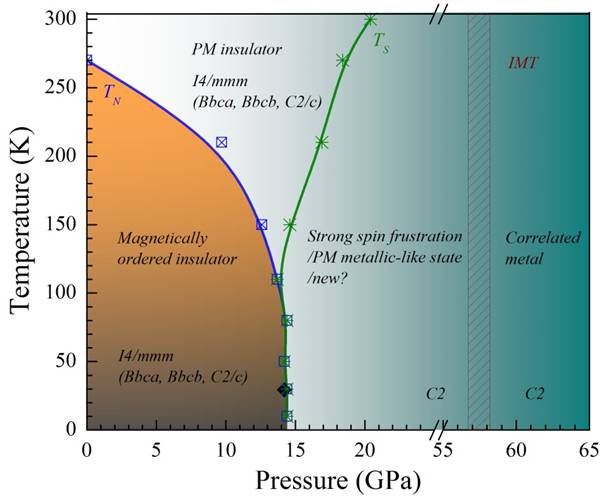Pressure Induced Lattice Frustration in Spin-Orbit Mott Insulator - Dr. Yang Ding
MAY 24, 2019
The intertwined charge, spin, orbital, and lattice degrees of freedom make the 5d compounds have exotic properties. Current interest is focused on electromagnetic interactions in these materials, whereas the important role of lattice geometry remains to be fully recognized. A group of scientists led by Dr. Yang Ding of HPSTAR, found pressure induced lattice frustration in a spin-orbit Mott insulator Sr3Ir2O7. Their work revealed the critical role of lattice frustration in determining the high-pressure phases of Sr3Ir2O7. This study is published in the npj Quantum Materials.
Determining the lattice variations in 5d materials remains a long-standing challenge. Recent studies show that high pressure opens up an avenue for such study because pressure could possibly decouple entangled degrees of freedom during phase transitions.
The double-layered perovskite Sr3Ir2O7 is the middle member of the Ruddlesden-Popper series Srn+1IrnO3n+1 (where n is the number of SrIrO3 perovskite layers between extra SrO layers). It is an ideal material for lattice variation study in 5d compounds due to its weak Mott limit with a relatively small charge gap and tiny magnetic moment.
The team of scientists applied Raman, electrical resistance, and x-ray diffraction measurements on single crystal Sr3Ir2O7 to investigate its structural variations and lattice-orbital coupling in the spin-orbit Mott insulators. The Raman spectra revealed a magnetic phase transition in Sr3Ir2O7 around 14.4 gigapascals from the variations of the one-magnon peak. It softens continuously and broadens with increasing pressure and eventually disappears. It’s interesting that the magnetic transition is not accompanied with an insulator-metal transition but with a structural change.
Their further spin-wave theoretical calculations show that the observed softening of the one-magnon mode can be explained by a reduced tetragonal distortion, while the actual magnetic transition is associated with tilting of the IrO6 octahedra.
“Since the changes of the tilting angles are mostly revealed from the slight movement of oxygen atoms, which can’t be detected by x-ray,” explained Dr. Jianbo Zhang. “So, it’s very challenging to study the lattice frustrations with x-ray. In contrast, our study shows that Raman spectra is very useful in studying the lattice frustration in this case.” Dr. Yang Ding added.

Caption: Schematic P-T phase diagram of Sr3Ir2O7.
自旋轨道耦合、库仑作用和晶体场作用之间的相互竞争使得铱氧化物具有独有的奇特量子态。特别是“Jeff=1/2”Mott 态被认为是自旋轨道和库仑相互作用在铱氧化物中相互竞争的体现。然而,这类材料的性质往往与传统智慧相悖:磁性和绝缘态之间缺乏相关性,高压下不易金属化,“S”形I-V特性等。且目前的实验结果与理论之间存在明显的差异。因此考虑晶格自由度被认为是解决这些问题的关键。北京高压科学研究中心的丁阳团队选取代表性的Sr3Ir2O7作为研究对象,借助拉曼和同步辐射技术发现了一个有趣的伴随着结构相变的磁相变。并指出这个磁相变是跟IrO6八面体的旋转和c轴方向的倾斜有关。我们的研究表明晶格自由度在决定Sr3Ir2O7的基态中起着至关重要的作用,同时也说明,通过压力调控晶体结构来控制材料的电磁特性,成为探索自旋轨道莫特绝缘体中的新量子态的一条有效途径。
